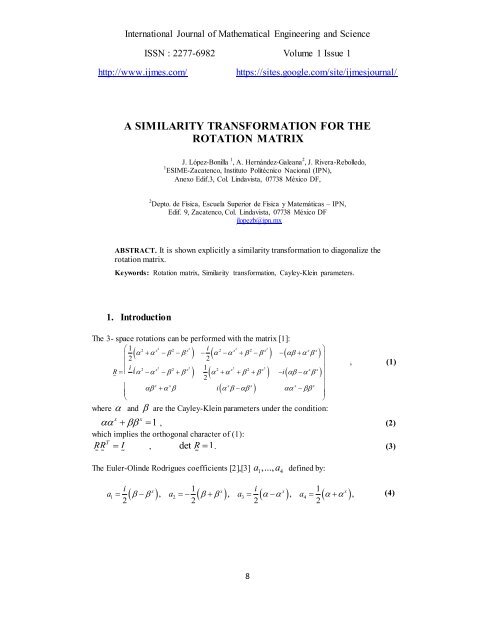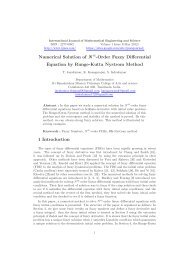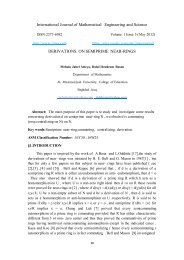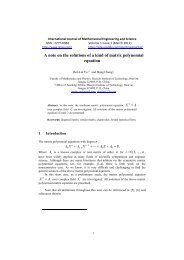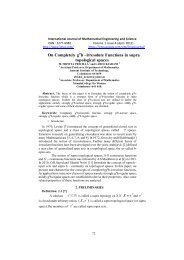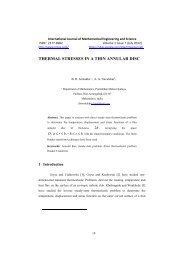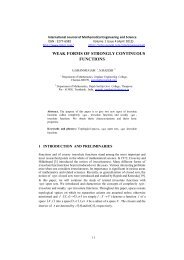Una transformación de similaridad para la matriz de rotación - ijmes
Una transformación de similaridad para la matriz de rotación - ijmes
Una transformación de similaridad para la matriz de rotación - ijmes
You also want an ePaper? Increase the reach of your titles
YUMPU automatically turns print PDFs into web optimized ePapers that Google loves.
International Journal of Mathematical Engineering and Science<br />
ISSN : 2277-6982 Volume 1 Issue 1<br />
http://www.<strong>ijmes</strong>.com/ https://sites.google.com/site/<strong>ijmes</strong>journal/<br />
A SIMILARITY TRANSFORMATION FOR THE<br />
ROTATION MATRIX<br />
J. López-Bonil<strong>la</strong> 1 , A. Hernán<strong>de</strong>z-Galeana 2 , J. Rivera-Rebolledo,<br />
1 ESIME-Zacatenco, Instituto Politécnico Nacional (IPN),<br />
Anexo Edif.3, Col. Lindavista, 07738 México DF,<br />
2 Depto. <strong>de</strong> Física, Escue<strong>la</strong> Superior <strong>de</strong> Física y Matemáticas – IPN,<br />
Edif. 9, Zacatenco, Col. Lindavista, 07738 México DF<br />
jlopezb@ipn.mx<br />
ABSTRACT. It is shown explicitly a simi<strong>la</strong>rity transformation to diagonalize the<br />
rotation matrix.<br />
Keywords: Rotation matrix, Simi<strong>la</strong>rity transformation, Cayley-Klein <strong>para</strong>meters.<br />
1. Introduction<br />
The 3- space rotations can be performed with the matrix [1]:<br />
12222 2 x 2 x i 2 x 2 x x x <br />
<br />
<br />
2 2<br />
<br />
<br />
i<br />
2 2 2 2<br />
2 x 2 x 1 2 x 2 x x x<br />
R i <br />
2 2<br />
<br />
x x x x x x <br />
i <br />
<br />
<br />
<br />
<br />
where and are the Cayley-Klein <strong>para</strong>meters un<strong>de</strong>r the condition:<br />
8<br />
, (1)<br />
x x<br />
1 , (2)<br />
which implies the orthogonal character of (1):<br />
T<br />
RR I , <strong>de</strong>t R 1.<br />
(3)<br />
The Euler-Olin<strong>de</strong> Rodrigues coefficients [2],[3] a1,..., a 4 <strong>de</strong>fined by:<br />
i x 1 x i<br />
x 1 x<br />
a1 , a2 , a3 , a4<br />
,<br />
(4)<br />
2 2 2 2
International Journal of Mathematical Engineering and Science<br />
ISSN : 2277-6982 Volume 1 Issue 1<br />
http://www.<strong>ijmes</strong>.com/ https://sites.google.com/site/<strong>ijmes</strong>journal/<br />
verify:<br />
by virtue of (2), so that (1) adopts the form:<br />
2 2 2 2<br />
a1a2a3a4 1 ,<br />
(5)<br />
<br />
2 2 a2 a3 a1a 2 a3a4 a1a3 a2a4 <br />
1 2 3 4 2<br />
1<br />
2<br />
3 2 3 1 4 <br />
a1a 3 a2a4 a1a 4 a2a3 <br />
2 2 a1 a2<br />
<br />
1222 <br />
R 2aaaa12aa2 a a a a ,<br />
<br />
2212 <br />
The rotation matrix represents [4] a rotation of the Cartesian axes through a Φ angle around the<br />
l , l , l , such that [3]:<br />
axis <strong>de</strong>fined by the unitary vector <br />
1 2 3<br />
a j l jSin,<br />
j 1,2,3 2 <br />
consistent with (5), since:<br />
,<br />
<br />
a4 Cos ,<br />
2 <br />
(7)<br />
2 2 2<br />
l1l2l3 1 . (8)<br />
Then (6) simplifies to:<br />
2<br />
l1 Cos <br />
R l1l2l3Sin <br />
l1l3l2Sin l1l2 l3Sin 2<br />
l2 Cos l2l3 l1Sin l1l3 l2Sin <br />
<br />
l2l3 l1Sin ,<br />
1 Cos<br />
,<br />
2<br />
l3 Cos<br />
<br />
<br />
(9)<br />
which is be studied in the present work.<br />
In next Section, the eigenvalue problem of (9) is used to write an R as a product of three<br />
matrices, which in turn explicitly shows the existence of a simi<strong>la</strong>rity transformation to<br />
diagonalize any rotation matrices.<br />
2. Eigenvalues and eigenvectors of R .<br />
The re<strong>la</strong>tion:<br />
R u u ,<br />
(10)<br />
expresses the eigenvalue problem for the rotation matrix, such that is quite known [5] that:<br />
9<br />
(6)
International Journal of Mathematical Engineering and Science<br />
ISSN : 2277-6982 Volume 1 Issue 1<br />
http://www.<strong>ijmes</strong>.com/ https://sites.google.com/site/<strong>ijmes</strong>journal/<br />
l1 <br />
1<br />
1 , u1 <br />
l2<br />
,<br />
l 3 <br />
e , e ,<br />
i x i<br />
2 3 2<br />
however, it is very difficult to find explicitly 2<br />
following three vectors, proportional among them:<br />
u . In fact, the eigenvector 2<br />
2 2<br />
l2 l 3 l1l2 il3 l1l3 il2<br />
<br />
2 2 <br />
l1l2il3 ,<br />
<br />
l1 l3 <br />
,<br />
<br />
l2l3 il1<br />
<br />
,<br />
2 2<br />
l1l3 il <br />
2 l2l3 il <br />
1 l1 l <br />
2 <br />
10<br />
(11)<br />
u can be any of the<br />
and it is chosen as the most convenient according to the values of l1, l2 and l 3 , for instance, if<br />
l1 l3 0 , l2<br />
1, the second vector is the trivial solution u2 0 , and in that case it can be<br />
used any other vector of (12). Without losing generality, here it will be used:<br />
2 2 2 2<br />
l2 l 3 l2 l<br />
3<br />
<br />
u2 l1l2 il3 , u3 u2 l1l2 il3<br />
.<br />
l l il l l il <br />
1 3 2 1 3 2 <br />
The problem of eigenvalues of a matrix gives algebraic information if it is also solved for the<br />
corresponding transpose matrix of (9) [6]:<br />
then getting the same eigenvalues (11), with:<br />
(12)<br />
(13)<br />
T<br />
R v v<br />
,<br />
(14)
International Journal of Mathematical Engineering and Science<br />
ISSN : 2277-6982 Volume 1 Issue 1<br />
http://www.<strong>ijmes</strong>.com/ https://sites.google.com/site/<strong>ijmes</strong>journal/<br />
<br />
1 1 <br />
<br />
2<br />
<br />
2<br />
<br />
l1 <br />
l1l2 il3 l1l2 il3<br />
v1 l2 , v <br />
2 , v <br />
<br />
2 2 3 <br />
,<br />
2 2<br />
2l2l32l2l3 l <br />
3 <br />
l1l3 il 2 l1l3 il 2<br />
<br />
2 2 2 2<br />
<br />
<br />
2l2l32l2l3 <br />
which together with (8) and (13) imply:<br />
Then it is natural to construct the matrices:<br />
11<br />
(15)<br />
v u .<br />
(16)<br />
T<br />
j k jk<br />
2 2 2 2<br />
l1l2l3l2l 3<br />
<br />
U u1 u2 u3 l2l1l2il3l1l2il3 lllilllil 3 1 3 2 1 3 2 <br />
100 Diag <br />
<br />
<br />
0 e<br />
0<br />
<br />
i<br />
e <br />
<br />
,<br />
i <br />
1 , 2, 3<br />
0 0 , 17 <br />
1 1 <br />
<br />
2 2<br />
<br />
l1 l1l2 il3 l1l2 il3<br />
V v1 , v2 , v3 l2 2 2 2 2<br />
2l2l32l2l3 l3 l1l3il2 l1l3 il 2<br />
<br />
2 2<br />
2 2 <br />
2l2<br />
l3<br />
2l2<br />
l3<br />
<br />
<br />
and because the property (16) it results:<br />
V U <br />
T 1<br />
.<br />
(18)<br />
,
International Journal of Mathematical Engineering and Science<br />
ISSN : 2277-6982 Volume 1 Issue 1<br />
http://www.<strong>ijmes</strong>.com/ https://sites.google.com/site/<strong>ijmes</strong>journal/<br />
1<br />
U because when choosing 2<br />
Notice the existence of<br />
u given by (13) it has been supposed<br />
2 2<br />
that l2andl 3 do not simultaneously cancel, so that <strong>de</strong>t U 2i l2 l3<br />
0 .<br />
General theorems of Linear Algebra [6] lead to the following factorization of the rotation<br />
matrix:<br />
(18)<br />
<br />
T<br />
<br />
1<br />
,<br />
(19)<br />
R U V U U <br />
which is easily seen through (8), (9) and (17). From (19) it is immediate that:<br />
12<br />
i i <br />
1 <br />
U RU Diag e e<br />
1, , , (20)<br />
that is, the U matrix given explicitly by (17) generates a simi<strong>la</strong>rity transformation which<br />
diagonalizes R , q.e.d.<br />
References<br />
1. L. H. Ry<strong>de</strong>r, Quantum field theory, Cambridge Univ. Press, Cambridge, Eng<strong>la</strong>nd (1996)<br />
Chap. 2, ISBN: 0-521-47242-3<br />
2. E. Cartan, The theory of spinors, Dover, New York (1981) ISBN: 0-486-64070-1<br />
3. E. Piña G., A new <strong>para</strong>metrization of the rotation matrix, Am. J. Phys. 51 (1983) 375<br />
4. W. Rindler, What are spinors?, Am. J. Phys. 34, No.10 (1966) 937<br />
5. E. Piña G., Dinámica <strong>de</strong> rotaciones, Div. CBI, UAM-I, México DF (1996) Cap. 1,<br />
ISBN: 970-620-919-0<br />
6. C. Lanczos, Applied analysis, Dover, New York (1988) Chap. 2, ISBN: 0-486-65656-X


